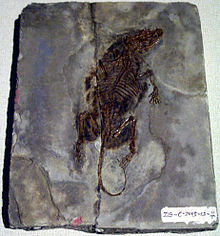Symmetrodonta: diferenças entre revisões
Conteúdo apagado Conteúdo adicionado
| Linha 45: | Linha 45: | ||
* TSUBAMOTO, T.; ROUGIER, G. W.; ISAJI, S.; MANABE, M.; FORASIEPI, A. M. (2004). '''New Early Cretaceous spalacotheriid “symmetrodont” mammal from Japan'''. ''Acta Palaeontologica Polonica'' 49 (3): 329–346. |
* TSUBAMOTO, T.; ROUGIER, G. W.; ISAJI, S.; MANABE, M.; FORASIEPI, A. M. (2004). '''New Early Cretaceous spalacotheriid “symmetrodont” mammal from Japan'''. ''Acta Palaeontologica Polonica'' 49 (3): 329–346. |
||
* CIFELLI, R. L.; MADSEN, S. K. (1999). '''Spalacotheriid symmetrodonts (Mammalia) from the medial Cretaceous (upper Albian or lower Cenomanian) Mussentuchit local fauna, Cedar Mountain Formation, Utah, USA.''' ''Geodiversitas'' 21 (2): 167-214. [http://www.mnhn.fr/publication/geodiv/g99n2a4.html Resumo] |
* CIFELLI, R. L.; MADSEN, S. K. (1999). '''Spalacotheriid symmetrodonts (Mammalia) from the medial Cretaceous (upper Albian or lower Cenomanian) Mussentuchit local fauna, Cedar Mountain Formation, Utah, USA.''' ''Geodiversitas'' 21 (2): 167-214. [http://www.mnhn.fr/publication/geodiv/g99n2a4.html Resumo] |
||
* SIGOGNEAU-RUSSELL, D.; ENSOM, P. (1998). '''Thereuodon(Theria, Symmetrodonta) from the Lower Cretaceous of North Africa and Europe, and a brief review of symmetrodonts'''. ''Cretaceous Reserch''. 19 )3-4): 445-470. [http://www.sciencedirect.com/science?_ob=ArticleURL&_udi=B6WD3-45K0Y0V-9&_user=10&_rdoc=1&_fmt=&_orig=search&_sort=d&view=c&_acct=C000050221&_version=1&_urlVersion=0&_userid=10&md5=4f3b482ccc67565dd7a5a493170d236f Resumo] |
* SIGOGNEAU-RUSSELL, D.; ENSOM, P. (1998). '''''Thereuodon'' (Theria, Symmetrodonta) from the Lower Cretaceous of North Africa and Europe, and a brief review of symmetrodonts'''. ''Cretaceous Reserch''. 19 )3-4): 445-470. [http://www.sciencedirect.com/science?_ob=ArticleURL&_udi=B6WD3-45K0Y0V-9&_user=10&_rdoc=1&_fmt=&_orig=search&_sort=d&view=c&_acct=C000050221&_version=1&_urlVersion=0&_userid=10&md5=4f3b482ccc67565dd7a5a493170d236f Resumo] |
||
* HU, Y.; WANG, Y.; LUO, Z-X.; LI, C. (1997). '''A new symmetrodont mammal from China and its implications for mammalian evolution'''. ''Nature'' 390:137-142. |
|||
* FOX, R. C. (1985). '''Upper molar structure in the Late Cretaceous symmetrodont ''Symmetrodontoides'' Fox, and a classification of the Symmetrodonta (Mammalia)'''. ''Journal of Paleontologia'' 59 (1):21-26. |
|||
* ENSOM, P.; SIGOGNEAU-RUSSELL, D. (2000). '''New symmetrodonts (Mammalia, Theria) from the Purbeck Limestone Group, Lower Cretaceous, southern England.''' ''Cretaceous Research'' 21: 767-779. |
|||
* GILL, P. (2004). '''A new symmetrodont from the Early Cretaceous of England'''. ''Journal of Vertebrate Paleontology'' 24 (3): 748-752. |
|||
* LI, G.; LUO, Z.-X. (2006). '''A Cretaceous symmetrodont therian with some monotreme-like postcranial features.''' ''Nature'' 439: 195-200. |
|||
==Ligações externas== |
==Ligações externas== |
||
Revisão das 23h01min de 25 de março de 2008
| Symmetrodonta | |
|---|---|

| |
| Classificação científica | |
| Reino: | |
| Filo: | |
| Subdivisão: | |
| Classe: | |
| Ordem: | Simpson, 1925
|
| Famílias | |
|
| |
Os simetrodontes (Symmetrodonta, do grego symmetros, "simétrico", e odont-, declinação de odous, "dente" ) são um grupo de mamíferos muito primitivos, que antigamente eram incluídos na Subclasse Prototheria. Nos últimos anos, o acúmulo de novas descobertas mudou muito as taxonomias propostas para o grupo, inclusive até pondo em dúvida se realmente constitui um grupo natural.
Classificação
Ordem SYMMETRODONTA Simpson, 1925
- Gênero Manchurodon Yabe e Shikama, 1938 Incertae sedis
- Família Kuehneotheriidae Kermack, Kermack e Mussett, 1968
- Gênero Kuehneotherium Kermack, Kermack e Mussett, 1968
- Gênero Delsatia Sigogneau-Russell e Godefroit, 1997
- Gênero Kotatherium Datta, 1981
- Família Shuotheriidae Chow e Rich, 1982
- Gênero Shuotherium Chow e Rich, 1982
- Família Tinodontidae Marsh, 1887
- Gênero Tinodon Marsh, 1879
- Gênero Gobiotheriodon Trofiamov, 1997
- Família Kuehneotheriidae Kermack, Kermack e Mussett, 1968
- Superfamília Spalacotheroidea Prothero, 1981
- Gênero Zhangheotherium Hu, Wang, Luo e Li, 1997
- Família Spalacotheriidae Marsh, 1887
- Gênero Spalacotherium Owen, 1854
- Gênero Shalbaatar Nessov, 1997
- Família Spalacolestidae Cifelli e Madsen, 1999
- Gênero Spalacotheroides Patterson, 1955
- Gênero Spalacolestes Cifelli e Madsen, 1999
- Gênero Spalacotheridium Cifelli, 1990
- Gênero Symmetrodontoides Fox, 1976
Referências
- AVERIANOV, A. O. (2002). Early Cretaceous “symmetrodont” mammal Gobiotheriodon from Mongolia and the classification of “Symmetrodonta”. Acta Palaeontologica Polonica 47 (4): 705–716. Completo
Bibliografia
- TSUBAMOTO, T.; ROUGIER, G. W.; ISAJI, S.; MANABE, M.; FORASIEPI, A. M. (2004). New Early Cretaceous spalacotheriid “symmetrodont” mammal from Japan. Acta Palaeontologica Polonica 49 (3): 329–346.
- CIFELLI, R. L.; MADSEN, S. K. (1999). Spalacotheriid symmetrodonts (Mammalia) from the medial Cretaceous (upper Albian or lower Cenomanian) Mussentuchit local fauna, Cedar Mountain Formation, Utah, USA. Geodiversitas 21 (2): 167-214. Resumo
- SIGOGNEAU-RUSSELL, D.; ENSOM, P. (1998). Thereuodon (Theria, Symmetrodonta) from the Lower Cretaceous of North Africa and Europe, and a brief review of symmetrodonts. Cretaceous Reserch. 19 )3-4): 445-470. Resumo
- HU, Y.; WANG, Y.; LUO, Z-X.; LI, C. (1997). A new symmetrodont mammal from China and its implications for mammalian evolution. Nature 390:137-142.
- FOX, R. C. (1985). Upper molar structure in the Late Cretaceous symmetrodont Symmetrodontoides Fox, and a classification of the Symmetrodonta (Mammalia). Journal of Paleontologia 59 (1):21-26.
- ENSOM, P.; SIGOGNEAU-RUSSELL, D. (2000). New symmetrodonts (Mammalia, Theria) from the Purbeck Limestone Group, Lower Cretaceous, southern England. Cretaceous Research 21: 767-779.
- GILL, P. (2004). A new symmetrodont from the Early Cretaceous of England. Journal of Vertebrate Paleontology 24 (3): 748-752.
- LI, G.; LUO, Z.-X. (2006). A Cretaceous symmetrodont therian with some monotreme-like postcranial features. Nature 439: 195-200.
